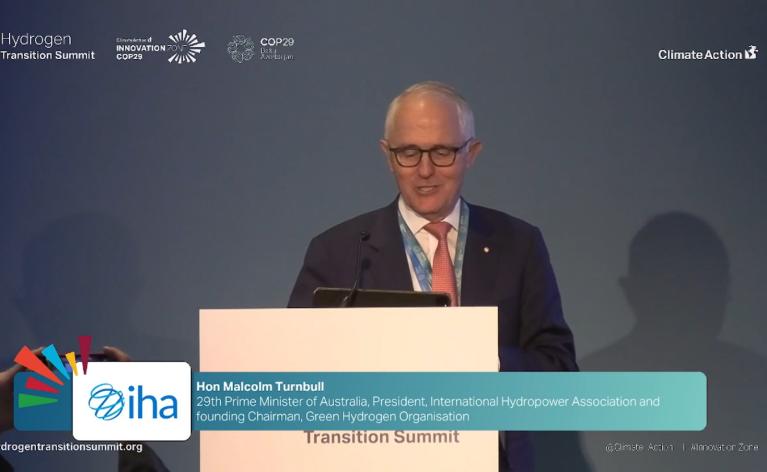Malcolm Turnbull at COP29 - Hydrogen Transition Summit
Speech notes from Malcolm Turnbull, 29th Prime Minister of Australia, President, International Hydropower Association and founding Chairman, Green Hydrogen Organisation.
From Climate Action Hydrogen Transition Summit, COP29, Baku

15 November 2024, 16.55-17.05
Let me begin by providing some political context to where the truly low carbon hydrogen sector finds itself…
It is clearly taking longer for the green hydrogen sector to take off than we had hoped for.
This is despite the price of renewable energy falling faster than anyone forecasted. Electricity generated from solar power is now cheaper than any other form of energy.
Think about it:
- In 2010, the global solar industry installed 17 gigawatts.
- By 2022, this rate had accelerated to nearly 1 GW per week.
- As of 2024, installations have surged to nearly 1 GW most days.
For green hydrogen, larger and more efficient electrolysers are now being built which is bringing down prices despite inflation in the supply chain.
It is clear that a lot is happening very quickly in China. Developments are almost as rapid in India, where a group of large companies, are moving ahead at great speed.
What we see in these countries are low costs where the government is offering extensive support and where there is often a high degree of vertical industrial integration.
In much of the rest of the world, we are still only replacing a tiny fraction of the nearly 100 million tonnes of grey hydrogen being produced annually with green hydrogen.
Let us take moment to consider what needs to happen to accelerate the production.
Firstly, I understand that the need for offtake, for orders, has been extensively discussed during today’s summit. Fundamentally, in many markets, our industry is struggling to compete with carbon-intensive alternatives.
There is no way around the need for national and international rules charging for carbon emissions. While we are likely to have to wait for a long time for universal rules, it is worth noting that a patch work is emerging.
One of the glimmers of hope I pick up at this COP, is the fact that there is growing global support for the International Maritime Organisation to take strong decisions next year for what they call a pricing mechanism and fuel standards. The Green Hydrogen Organisation, working together with Argus Media, reckons that 300 million tonnes of green ammonia will be needed by 2040, and of this 240 million tonnes will be for shipping.
Industry is also signalling to governments what needs to happen more clearly. This week an open letter organised by the Industrial Transition Accelerator and backed by 50 global business leaders and a network of more than 700 financial institutions called for policies like carbon pricing, mandatory quotas, and green public procurement in order to unlock green industrial projects and overcome the price gap between green commodities and those made with fossil fuels.
It was not long ago we pleaded with the private sector to invest, innovate and help find the pathways. This has largely worked. Now we need the governments to provide the enabling environment required.
Secondly, we need robust standards and we need to use standards and language which does not oversell and which does not lend credibility to hydrogen which isn’t actually clean. We need to stop talking about clean hydrogen, without defining what we mean.
When I founded the Green Hydrogen Organisation together with Andrew Forrest 3 years ago, I wrote:
“CCS has received billions of dollars in research and development over many years. There were high hopes for it. I shared them when I was Australia’s Environment Minister in 2007. But now we know that it is simply not commercially viable. It has failed, and not for want of trying. Its only value is as a means of delaying the necessary transition away from fossil fuels.”
Today, in 2024, I hear just as much talk of carbon capture, though I don’t see the projects that deliver high capture rates to deliver genuinely low carbon hydrogen. And I don’t hear about carbon capture projects which don’t require hugely significant subsidies.
The talk about methane abatement during this COP has also been encouraging. We have to recognise that this is also a problem for blue hydrogen. We need to limit methane leakage – a gas which is more than 80 times more potent than carbon dioxide over 20 years in terms of warming the climate plant – to near zero for blue hydrogen production and need reporting to be transparent and verified.
Jonas Moberg, CEO of the Green Hydrogen Organisation, said earlier this week:
“I wish we at GH2 didn’t have to involve ourselves in debates about methane leakage and fossil-fuel based (blue) hydrogen. But as weak standards and efforts lending credibility to blue hydrogen done badly undermines green and genuinely low carbon hydrogen, we don’t have a choice.”
And my successor as GH2 chair and friend, Sharan Burrow, the former General Secretary of the International Trade Union Confederation, has done more than anyone to argue for a just energy transition, and this message is more important than ever.
This means that we in the renewables sector need to be serious about land and water use, and local economic development. It is for this reason that the Green Hydrogen Organisation’s Green Hydrogen Standard, has strong language on water management.
One of the few important things I remember from last year’s COP is what Greg Jackson, CEO of Octopus Energy told me: “that 80% of citizens like wind turbines near their homes, provided they bring economic benefits.”
Thank you